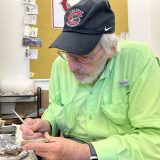Learning From History A conversation about the challenges women faced in science.
April 1, 2019
In the spirit of Women’s History Month, our Schmid College Assistant Dean of External Relations and Associate Professor of Chemistry, Dr. Elaine Schwartz, organized for a group of students and faculty to see the play PhotoGraph 51 at the South Coast Repertory on Wednesday, March 13, 2019.
PhotoGraph 51 focuses on the life of English physical chemist, Rosalind Franklin, who studied X-ray diffraction technology. Franklin is best known for her research on DNA structures and the discovery that the structure of DNA is a double-helix polymer spiral, but she was never publicly recognized for this discovery. In 1962, her colleagues James Watson, Francis Crick, and Maurice Wilkins were awarded the Nobel Prize in Physiology or Medicine for their work on the same research. The play follows Franklin throughout her time at King’s College in London during the 1950s as she made this monumental breakthrough and how she endured in a world dominated by men.
There were several themes throughout the play that resonated with our students and faculty. The first being the lack of respect for women during that time period. Even though women were allowed to continue their education and pursue research, there were still many hurdles women would face to have their work recognized.
Assistant Professor of Chemistry, Dr. Allegra Liberman-Martin recalled, “I thought the play did a great job of portraying challenges that female scientists may have faced at the time. Watching the play inspired me to do more reading about Franklin and her scientific discoveries beyond her X-ray data for DNA!”

Following the performance, there was a panel discussion about the challenges Rosalind Franklin faced and the main themes of the play.
Biochemistry and molecular biology student, Abbi Eli ’20, commented on how the play reflected the issues of being competitive versus collaborative in a research environment. In the panel discussion following the play, it was mentioned that there were several consequences Franklin and her rival Maurice Wilkins faced for not working together. Eli ’20, reflecting on her own academic experience here at Chapman, is grateful that as a university we foster a culture of collaboration.
Eli ’20 explains, “With the competitive atmosphere that pervades the world we live in, it makes sense that most researchers and scientists would be reclusive, guarded, and always on the hunt for opportunities to get a leg up on their competition, rather than being collaborative from the very beginning of their careers. The increasingly difficult standards for publishing that are present in many “popular” fields of research are one of the driving factors behind this competition, I feel, and it is in this regard that Chapman flips the expectations.”
Here in Schmid College, we recognize the value of collaboration. There is a level of collegiality among our outstanding faculty that is highly uncommon and uniquely Chapman. That is why from day one we encourage our undergraduates to connect with our faculty and students outside of their disciplines to work together as they push the boundaries of scientific discovery. Who knows what Franklin and Wilkins might have accomplished if they had worked together from the beginning.


